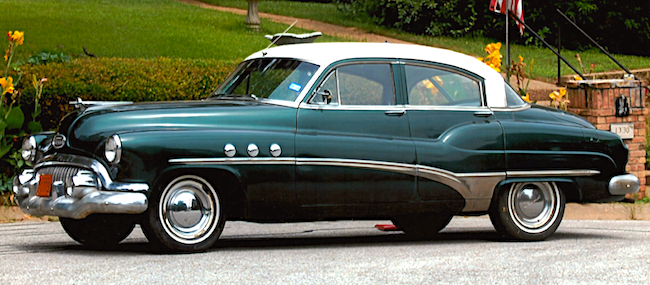The image captions below trace major Sweepspear variations from its inception until its final appearance before being abandoned for the 1959 model year. Unless noted, images are of cars listed for sale.
1949 Buick Roadmaster Convertible - Mecum auction photo
Sweepspears first appeared during the 1949 model year. The car above is a pre-Sweepspear Roadmaster convertible.
1949 Buick Roadmaster Convertible
And here is a Roadmaster convertible with a Sweepspear.
1949 Buick Roadmaster Riviera - General Motors Heritage Center photo
Sweepspears also appeared on the new-concept hardtop convertible. For 1949, they were found only on Roadmaster convertibles and hardtops.
1950 Buick Roadmaster Sedan - The Henry Ford photo
Buicks were redesigned for 1950. Sweepspears again were only on top-of-the-line Roadmasters that year.
1951 Buick Special
Specials did not use the "A" bodies of Supers and Roadmasters. But for 1951, all Buicks sported Sweepspears.
1951 Buick Super Tourback Sedan - Mecum photo
Here is a Sweepspear on a 1951 Super.
1952 Buick Super Riviera - my photo
Sweepspears lost their aft chrome splash panels in 1952.
1953 Buick Skylark
Buicks sporty Skylark had round wheel openings front and rear, and the Sweepspear was extended over the rear opening.
1953 Buick Super Convertible
Other Buicks retained 1952-version Sweepspears.
1954 Buick Super Riviera - Mecum photo
The Buick line was redesigned for 1954. Sporty models had round rear wheel openings, so the 1953 Skylark Sweepspear design was used.
1954 Buick Super on Argonaut Building roof
Buicks lacking round rear wheel openings got Sweepspear extensions fitting the openings' contours.
1955 Buick Super - Mecum photo
1956 Buick Century - Mecum photo
No important Sweepspear changes over the life of the 1954-1956 bodies for the lesser Buick models.
1956 Buick Roadmaster
However, line-leading Roadmasters had Sweepspears that did not drop to the rocker panel.
1957 Buick Special
The redesigned Buick line for 1957 also had the less-shapely Sweepspears. This is an entry-level Special sedan.
1957 Buick Roadmaster - Barrett-Jackson auction photo
A top-of-the-line Roadmaster.
1958 Buick Super Riviera
General Motors cars received a crash facelift for 1958. The results for Oldsmobile and Buick were especially garish. Now the Sweepspear is an extension of headlight assembly décor. Round rear wheel openings were abandoned so that the strange faux air exhaust panel could be incorporated in the visual clutter. Aft Sweepspear segments were altered accordingly.
Speculation
1947 Buick Roadmaster Convertible - Mecum photo
Also, it's interesting to compare the Sweepspear design on that 1957 Roadmaster above with the upper front-and-rear fender profile of the 1947 Buick shown here. Not identical, of course, but in the same spirit.


















No comments:
Post a Comment